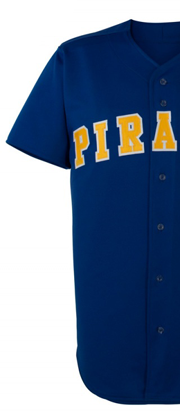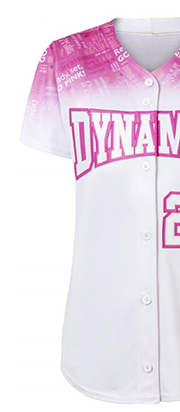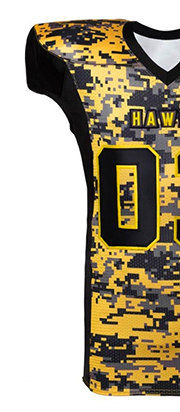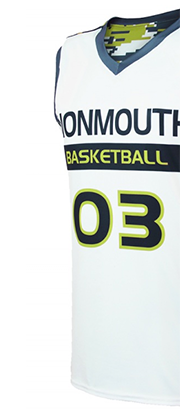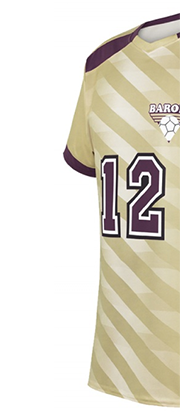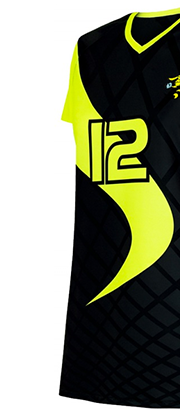Football Uniform Regulations
The first thing to understand when designing your football team jersey is that rules can vary depending on your local organization, so always be sure to double-check those. But if you follow the guidelines below, you won’t go far wrong. Note that all guidelines either equal or exceed NFHS standards:
HIGH SCHOOL FOOTBALL
All players must use professionally made uniforms and equipment. A high school ‘uniform’ is defined as: jersey, pants and socks.
Standard equipment is defined as: helmet with proper face mask and chin strap, knee pads, shoulder pads, hip pads, thigh guards, tailbone protector, and shoes with cleats.
Colors, Jersey, Numbers
The jersey has to be big enough to at least reach the top of the pants, and the shoulders must completely cover the shoulder pads. Numbers can only be between 1 and 99 and must be clearly visible.
The number must be one-and-a-half inches wide. On the back it must be at least 10 inches high while in the front it must be at least eight inches high. On both sides the number has to be horizontally centered. The number must have the same color and design on both sides. In order for the number to stand out properly, the color must contrast with the color of the jersey, or have a border of no less than a quarter-inch in width that provides the contrast.
Visiting Teams
Since 2012, the following rules have applied for visiting teams:
The main body of the jersey must be white. ‘Body’ is defined as from inside the shoulder area, below the collar, down to the bottom of the jersey. Below are the allowable ornaments. All ornaments must contrast with white:
-Team name and number on body or shoulders
-Player name on body or shoulders
-Decorative stripes that follow the curve of the sleeve or shoulder seam of the yoke, not more than one inch within the jersey’s body; or is added after production to the shoulder area and doesn’t exceed one inch per stripe, or a combination of stripes no more than 3.5 inches in total.
-Decorative stripes cannot be more than one inch in width on the collar
-Decorative stripes on the side seams can be a maximum of four inches in width, but if on the body of the jersey must be white in color
The Home Team Jersey
Since 2012 it has been stipulated that the body of the jersey cannot contain the color white, with the exception of:
-The jersey number or the team/player name
-Stripes on shoulders or sleeves
-Stripes on side seams or collar
Protective Equipment
All protective equipment must be covered by the jersey. Below is a list of outlawed equipment:
-Jerseys that tear off
-Jerseys or pants that display the following:
-Trademarks or logos greater than two-and-a-quarter square inches
-Any more than one manufacturer’s logo or trademark
-Labels on the outside of items that aren’t logos
-Gloves, helmets, jerseys, patches or helmets that clash with the color of the ball
-Anything that could “enhance contact with the football or opponent”, excluding gloves
Patches and Flags
Flags cannot be worn that are any larger than 2×3 inches. State approval must be granted for all commemorative patches, and they must not obstruct the view of the number or be any bigger than four square inches.
COLLEGE FOOTBALL
The guidelines below are derived from the Official NCAA Football Rules and Interpretations.
Colors, Jersey, Numbers
The jersey has to be big enough to at least reach the top of the pants, and the shoulders must completely cover the shoulder pads. Numbers can only be between 1 and 99 and must be clearly visible.
See the number guide below:
1-49: Backs
50-59: Snapper
60-69: Guard
70-79: Tackle
80-89: End
-Five or more players in any scrimmage must be numbered 50-79
-No two players from the same team are allowed the same number in a single down
-No markings are allowed in the number area
-Numbers must be eight inches high on the front of the jersey and ten inches high on the back. They must be a different color to the jersey and the same for all team members.
-Individual bars must be approximately one-and-a-half inches wide
-The jersey number must be replicated on numbers that appear on any other part of the uniform
Opposing teams must wear contrasting colors. All players must wear identical jerseys. Visiting teams must wear white but home team may also wear white as long as both teams agree. On condition, both teams are allowed to wear colored jerseys. For more extensive conditions and violations, see the rules.
Jersey Markings
Any white jersey must be contrasted by a colored number. Jerseys must contain the name of the player and the school, logo of the school, and is allowed to contain insignias providing they are approved. The American flag is also allowable. More extensive information can be found in the official rules.
Extras
The back of gloves or hand pads must be gray. Penalties are outlined in the rules. Any memorial insignia may not exceed one-and-a-half inches in diameter. Socks must always be visible and be the same color and length across all team members.
Below is a list of illegal equipment:
-Prosthetics that give a player an unfair advantage
-Hard objects on the hand or any other area, unless protected by one-and-a-half inch foam
-Exposed knee braces or unpadded thigh guards
-Metal projectiles
-Tapes or bandages that are unnecessary
-Any jerseys, helmets or attachments that clash with the color of the ball
-Substances that may jeopardize contact
-A face mask that contains any breakable material
-Shoulder pads that haven’t been approved
-Jerseys that are tied or taped
-Attachments to uniforms (with exceptions)
-Rib pads or any protectors that aren’t covered
-Bandanas
-Eye shields that are non approved
-Cleats that fit the below criteria:
-Detachable cleats:
-More than half an inch long (with exceptions)
-Made of material subject to chipping and fracture
-Cleats without locking device
-Cleats without concave sides
-Any cleats that are steel, oblong or circular
-Non-detachable cleats:
-More than half an inch long
-Made of material subject to chipping and fracture
-Any cleats that have an abrasive or cutting surface
-Metal cleats

